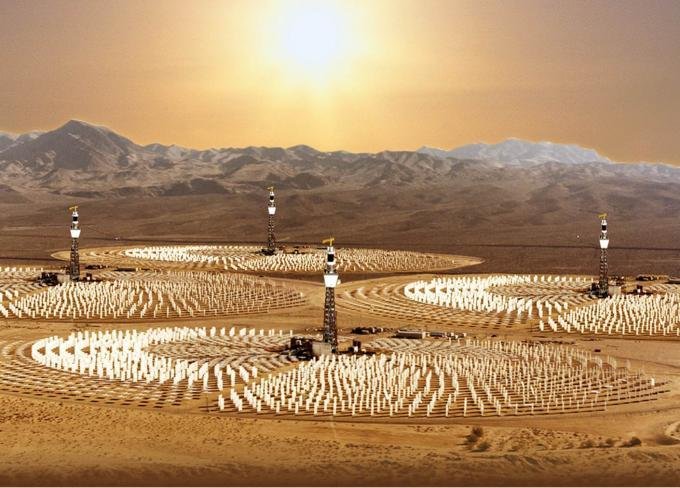An artist's conception of a commercial hydrogen production plant that uses sunlight to split water in order to produce clean hydrogen fuel. (Image courtesy University of Colorado Boulder)
Scientists have devised a new, more efficient technique for creating hydrogen fuel by using the power of the sun -- and they say no one will bother to build it until carbon is too expensive.
"Splitting water with sunlight is the Holy Grail of a sustainable hydrogen economy," said University of Colorado Boulder professor Alan Weimer.
The CU-Boulder researchers' solar-thermal system would use a vast array of mirrors to concentrate sunlight on a point atop a tower several hundred feet tall.
The tower would gather heat to around 2,500 degrees Fahrenheit (1,350 Celsius), then send it into a reactor containing metal oxides. As the compounds heat up, they lose oxygen atoms.
Steam would be released, using water boiled from the tower heat, and the metal oxide compounds that have lost oxygen will pull oxygen from the steam, leaving hydrogen molecules to be harvested.
The system is groundbreaking in that it conducts two chemical reactions at the same temperature. Producing hydrogen through a metal oxide process theoretically requires heating the reactor to release oxygen, then cooling it before introducing steam.
"One of the big innovations in our system is that there is no swing in the temperature. The whole process is driven by either turning a steam valve on or off," said co-lead author Charles Musgrave.
"While we can easily heat it up to more than 1,350 degrees Celsius, we want to heat it to the lowest temperature possible for these chemical reactions to still occur," said co-author Christopher Muhich.
With their system, the amount of hydrogen produced for fuel cells or storage is limited only by the amount of metal oxide -- a combination of iron, cobalt, aluminum and oxygen. Reactor tubes several feet long, filled with metal oxide material, would be stacked on top of each other.
To produce a significant amount of hydrogen gas, a number of tall towers would collect concentrated sunlight from several acres of mirrors surrounding each tower.
The research was supported by the National Science Foundation and the U.S. Department of Energy, and published in Science, but despite the discovery, commercialization of the solar-thermal reactor for broad hydrogen power is likely years away.
"With the price of natural gas so low, there is no incentive to burn clean energy," said Weimer, also the executive director of the Colorado Center for Biorefining and Biofuels, or C2B2. "There would have to be a substantial monetary penalty for putting carbon into the atmosphere, or the price of fossil fuels would have to go way up."















